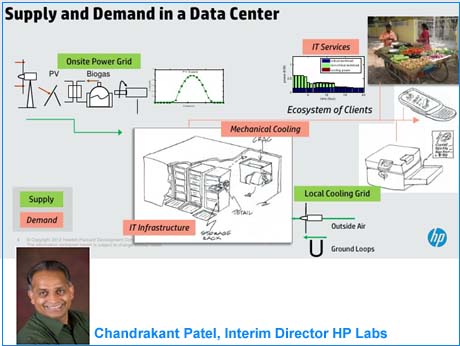
Bangalore, June 3, 2012 — Multiple teams at HP Labs, the company’s central research arm, have unveiled that architecture for a data centre that requires no net energy from traditional power grids.The research shows how the architecture, combined with holistic energy-management techniques, enables organizations to cut total power usage by 30 percent, as well as dependence on grid power and costs by more than 80 percent. The work was highlighted last week in a research paper “Towards the Design and Operation of Net-Zero Energy Data Centres,” presented at IEEE’s 13th annual Intersociety Conference on Thermal and Thermomechanical Phenomena in Electrical Systems
The work was led by Chandrakant Patel, Interim Director, HP Labs who founded the thermal technology research program, and with partners in the R&D groups, started a virtual thermal community , to productize the electronics cooling research in HP Laboratories.
“Information technology has the power to be an equalizer across societies globally, but the cost of IT services, and by extension the cost of energy, is prohibitive and inhibits widespread adoption,” s ays Cullen Bash, distinguished technologist, HP, and interim director, Sustainable Ecosystems Research Group, HP Labs. “The HP Net-Zero Energy Data Center not only aims to minimize the environmental impact of computing, but also has a goal of reducing energy costs associated with data-center operations to extend the reach of IT accessibility globally.” (see Bash explain the idea in our Video spot)
The HP Net-Zero Energy Data centre architecture integrates energy and cooling supply from local renewable sources, with a novel demand-management approach that allows the scheduling of IT workloads based on resource availability and performance requirements.
For example, noncritical, delay-tolerant workloads could be scheduled during daylight hours to coincide with solar supply for data centers equipped with photovoltaic energy generation. In this way, demand can be “shaped” according to resource availability to reduce reliance on nonrenewable resources. As a result, organizations can lower overall data-center costs—from capital investment in upfront infrastructure technology to the operational costs of workload execution—enabling more customers to take advantage of IT services.
The architecture for net-zero energy
The HP Net-Zero Energy Data Centre is based on a management architecture that integrates energy and cooling resources with IT workload planning through four modules:
• Prediction Module: Leverages powerful predictive analytics software to forecast the availability and cost of critical resources, such as renewable energy and IT workload demand.
• Planning Module: Delivers an optimization algorithm that balances workload scheduling with high-level operational goals, such as achieving net-zero energy operation, enabling organizations to schedule workloads based on resource availability, while meeting data-center operational goals.
• Execution Module: Enables organizations to manage workload and energy consumption in real time according to performance requirements and data-center operational objectives.
• Verification and Reporting Module: Identifies and remediates misalignment between the plan and execution, ensuring plan accuracy. As part of the HP Open Innovation initiative, the Prediction Model leverages technologies developed by HP Labs in conjunction with Virginia Tech (Blacksburg, Va.) and the University of Limerick (Ireland).
Image: HP Net-Zero Energy Data Centre architecture http://www.flickr.com/photos/hpnews/7298914678/in/photostream
Slides: Illustrating the HP Net-Zero Energy Centre architecture http://www.slideshare.net/hewlettpackard/hp-net-zero-energy-data-center-media-presentation